Livestock Resource F&R
Your direct source for livestock news and information
Published by Farmers & Ranchers Livestock, Salina, Kansas
In this Issue:
1 Post-Pasture Learning
The American Hereford Association Feedout Program and National Junior Hereford Association Fed Steer Shootout are providing important genetic and end product performance data for both seedstock suppliers and commercial producers using Hereford genetics. Participants learn about cattle feeding and beef packing sectors as they receive performance “report cards” on the cattle.
7 Marketing Feeder Cattle? Begin With the End in Mind



Paul Dykstra, Certified Angus Beef, reminds producers marketing feeder cattle to understand what constitutes value. Today packers look for cattle that will meet high quality benchmarks (Certified Angus Beef®, Prime, 100% Choice) and have excellent red meat yield. Selecting above-average genetics for important end product traits, like marbling and feed conversion, give you a head start on the progeny being worth more.
12 Cattle Prices on Record Pace

Cash fed steer prices set a nominal record high price in early April and have continued to rise. Reasons behind the prolonged, steeply higher price path have everything to do with fewer cattle and reduced beef production in tandem with resilient beef demand.
16 Prolonged Drought Leaves Mark on Beef Industry

Drought throughout the Southern Plains has taken a toll on Oklahoma and southwest Kansas cattle producers over the past two years. Drought Monitor maps from the Oklahoma Mesonet consistently displayed a drought line from northeast to southwest. Recent rains have provided relief to some, but difficult decisions may yet to come relative to further herd reductions.
Post-Pasture Learning
Hereford Feedout Programs continue to grow interest and value.
By Wes Ishmael
“We would all love to identify that one bull that does it all—easy birth weight, his cattle all grow and they all grade well and feed well,” says Lee Mayo, general manager of HRC Feed Yards, Scott City, Kansas. “The only way to get the information needed to identify that bull is by testing the genetics. That’s what these programs are about.”
Mayo refers to the American Hereford Association (AHA) Hereford Feedout Program1 and the National Junior Hereford Association Fed Steer Shootout2. Both provide Hereford breeders and commercial users of Hereford genetics the opportunity to send a few head or entire pens to feed
at HRC Feed Yards. Participants learn more about the cattle feeding and beef packing sectors while collecting performance data from their cattle.
“As a registered breeder, we just needed to do it, and all of the stars aligned this year,” explains first-year participant, Matt Beery of Beery Land and Livestock (BLL), Vida, Montana. “We’re hoping to bring this information back to our bull customers and say, ‘Here’s how your bulls’ younger brothers do in the feedlot and as carcasses.’”
The BLL program includes both seedstock and commercial herds. The


PRSRT STANDARD U.S. POSTAGE PAID Jefferson City, MO 65101 Permit #303 Summer 2023 | Volume 6, Issue 4
Continued on page 4
Nematodirus (shown here), also known as the thread-necked intestinal worm, is an unsightly parasite that causes infections marked by diarrhea and loss of appetite − both of which open the door for other internal parasites to cause even more damage.

Choose Safe-Guard® (fenbendazole) when you deworm to take out more profit-eating parasites.
SAFE-GUARD is proven to kill 98.7% of worms, remaining powerful and effective, even in the face of parasite resistance.1 Choosing two dewormers from two different classes (like SAFE-GUARD + ivermectin) can help ensure you’re getting the toughest parasites – and helping slow the growing issue of parasite resistance.

BITE BACK AT KILLMOREWORMS.COM
IMPORTANT SAFETY INFORMATION: Do not use in beef calves less than 2 months old, dairy calves and veal calves. A withdrawal period has not been established for this product in pre-ruminating calves. Additionally, the following meat withdrawal and milk discard times apply: SAFE-GUARD Paste: Cattle must not be slaughtered for 8 days. For dairy cattle, the milk discard time is 96 hours. SAFE-GUARD Suspension: Cattle must not be slaughtered for 8 days. For dairy cattle, the milk discard time is 48 hours. SAFE-GUARD
En-PRO-AL Type C Medicated Block: Cattle must not be slaughtered for 11 days. For use in beef cattle only. SAFEGUARD 20% Protein Type C Medicated Block: Cattle must not be slaughtered for 16 days. For use in beef cattle only. SAFE-GUARD medicated feed products (pellets, cubes, free-choice mineral, or free-choice liquid): Cattle must not be slaughtered for 13 days. For dairy cattle, the milk discard time is 60 hours.
1Reinhardt CD, et al. A fenbendazole oral drench in addition to an ivermectin pour-on reduces parasite burden and improves feedlot and carcass performance of finishing heifers compared with endectocides alone. J Anim Sci. 2006;84(8):2243-50.
MAHCattle.com • 800-521-5767 © 2022 Intervet Inc., doing business as Merck Animal Health, a
of Merck
Co., Inc. All rights reserved. US-SFG-200400001
subsidiary
&
Livestock Resource F&R
Published quarterly by Farmers & Ranchers Livestock, Salina,
By Deb Norton
Owner:
Editor:
Production
Graphic
Daric Wells
Editorial Assistants: Dixie Russell, Dave Cumpton

Contributing Editors: Wes Ishmael, Paige Nelson, Sara Gugelmeyer
Contributing Artist: Ted Foulkes
A lifetime spent in agriculture with the majority of a career spent in beef industry marketing, yields an interesting perspective relative to modern communications. Living in a city and doing the stuff city people do, like shopping at a variety of supermarkets or big box stores on a daily basis, keep me grounded in the importance of the generational work of beef producers and livestock agriculture.
We saw supply and inventory challenges at the retail stores during the pandemic. Those challenges were the result of delivery and logistics and not by lack of supply. In fact, beef processing was faced by unprecedented challenges to keep enough healthy employees on the processing floor to move beef out the door and onto trucks. Finished cattle were always in the pipeline waiting to be processed.
No doubt challenges ranging from drought, wildfires, floods, pandemic, geopolitics and inflation seem never ending. However, optimists recognize almost every challenge as an opportunity to rethink, reset and restore. As a result, ultimate optimists are also some of the most progressive beef producers. These producers, some as far back as 30 years, have embraced market challenges and recognized the most sustainable path forward for their operations was investing in changes to take advan-
tage of a value-added marketing system.
While optimism is always an option, until the first National Beef Quality Audit (NBQA) published in 1991, optimism was largely a pipe dream. Very little measurable, quantifiable change had been made in beef production or how beef was marketed. Producers had no road map, market signals or direction to suggest change. Basically, all live cattle were priced on an average. The most recent NBQA documents real change made in the last three decades. The beef industry has every reason to be optimistic. Scarlett Hagins, vice president of communications at the Kansas Livestock Association, recently outlined the progress in “Keep Getting Better”, July 2023, Kansas Stockman. “The 2022 audit revealed the highest number of carcasses grading Prime and Choice since assessments began, which proves a good job is being done in selecting genetics that are going to produce that type of beef. Additionally, there were almost no injection-site lesions found in the audit. …today, many of these concerns have been addressed due to the entire industry—from ranchers to feedyard managers to meat scientists to packers—spending decades adjusting factors that help determine beef’s quality. What previously was reserved for high-end steakhouses, cuts grading Prime and Choice, now are available at supermarkets nationwide at price points that fit a variety of budgets.”
Because of the optimism of many, regardless of the information available at the time to make progress, ranchers and farmers have persisted to make significant quality, safety and nutritional improvements to the food supply. Moving back down the supply chain to producers, their investments in science and technology have challenged traditional business models and inspired directional changes. Progressive stakeholders across the entire beef production space are more apt to acknowledge the value of collaboration between sectors. As cow-calf producers, cattle feeders and packers decided that “skin thy neighbor” was a zero-sum game and a value-based marketing system could result in predictable, higher quality outcomes and collaboration became the pathway forward.
Back to living in the city. Conversations with city friends, disconnected from agriculture but consumers nonetheless, are the lifeblood of our industry’s existence and largely uninformed yet vulnerable to misinformation. It is encouraging to see the energetic movement among the next generation of decision makers that recognize the importance of “agvocacy”—transparent, innovative, honest and informative/educational communication directly with
F&R Advertisers / Page / Sale Date
F&R Livestock Resource page 3
Produced by
www.CogentIdeasInc.com
Issue 4 Summer
Volume 6,
2023
Kansas 1500 W. Old Hwy 40 Salina, Kansas 67401 (785) 825-0211 • (785) 826-1590 (fax) FandRLive.com find us on Facebook Facebook.com/FarmersAndRanchersLivestock
Farmers & Ranchers Livestock, Mike Samples, Salina, Kansas (785) 826-7884
Norton,
Deb
Deb@CogentIdeasInc.com
Coordinator:
Julie Tucker
Designer:
Sales Jay Carlson Carlson Media Group, LLC (913) 967-9085 Subscriber Questions: To be added or removed from our mailing list, contact Julie Tucker, Julie@ CogentIdeasInc.com or (785) 408-1214. F&R Livestock Resource is published quarterly with mail dates of January 15, March 1, August 15 and October 1 by Farmers & Ranchers Livestock, Salina, Kansas. Continued on page 10
Editor
From the
Farmers & Ranchers Upcoming Sales and Events Special Cow Sales (Tuesdays) Beginning August 15 Hog Sales 2nd & 4th Monday Each Month, 11:00 AM Weekly Cattle Sales Thursdays, 10:00 AM Fall Classic Catalog Horse Sale............................................................ October 14 Rope Horse Preview October 13 15th Annual F&R Futurity October 13 26th Annual Fall Colt & Yearling Catalog Sale October 15 For advertising information, contact: Jay Carlson | Carlson Media Group (913) 967-9085 • Jay@CarlsonMediaGroup.com Don’t miss our next issue Fall 2023. 44 Farms 18 October 28 Gardiner Angus Ranch 11 September 25 Jamison Quarter Horses 17 October 5 Jorgensen Land & Cattle 9 September 16 Santa Fe Ranch 16 October 5 Seedstock Plus 14 August 19, October 21, November 4 Farmers & Ranchers Livestock Commission Co., Inc. Salina, Kansas • (785) 825-0211 Optimism is always an option
Beerys utilize AI intensively to build bulls their customers want.
“Our specialty is working with commercial cow-calf producers trying to produce large groups of closely related genetics,” Beery explains. “We sell lots of half-brothers and three-quarter brothers. Ninety percent of our Hereford bulls go on black Angus cows to make them better. We push to our customers the value of the F1 and using Hereford bulls on their black cows.”
BLL ends up with 100 or so Hereford and red baldy steers each year. They background the steers and market them as feeder calves weighing 800-900 pounds. No matter how good the cattle, or the method used to market them, Beery says the cattle are often discounted because they comprise mixed loads—Hereford and red baldy—rather than a straight load of one of the other.
Beery sent 54 straightbred Hereford steers and 52 red baldy steers to feed and evaluate at HRC. While also a marketing decision, more than anything, he says it is the chance to see how his cattle perform in the feedlot and on the rail, to improve his program and help the Hereford breed.

Currently, 94 participants from 22 states are feeding more than 1,400 head of Hereford and Hereford-influenced feeder cattle at HRC Feed Yards.
Hands-On Learning
Beery took advantage of the annual Fed Steer Shootout Field Day April 15 to visit HRC and see his cattle.
“I wish more people could see this side of the business and understand it. I wish I could have had 50 of my commercial producers with me that day,” Beery says. “When I showed up, all of the cattle across the yards were so clean and so well taken care of. I was so happy to see what Lee is doing. It’s just a win-win for us, for the breed and all of the way through.”
Mayo and his crew welcomed more than 100 participants and guests to the field day, which included intensive informational and hands-on educational sessions, including the following.
• A talented team from Cargill Protein North America led producers through rotations, including a carcass cutout demonstration, along with focuses on beef quality and consistency, carcass defects and cattle hide value points.
• Corbin Stevens, DVM, HRC Feed Yards consulting veterinarian, performed necropsies and showed participants the difference between healthy bovine lungs and those scarred by respiratory infection.
• AHA staff led participants through the ins and outs of live market cattle evaluation including estimating grade and yield to arrive at value differentiations.
• Kevin Good, CattleFax vice president of industry relations, provided an overview of current cattle markets and the drivers behind them.

• Gregg Barfield, president, BlockTrust Network and Mike John, MFA Health Track manager, introduced a new information sharing system fueled by blockchain technology.
“The field day continues to strengthen the overall program,” says Trey Befort, AHA director of commercial programs. “Our hands-on approach to education brings a lot of value to the experience. Once program participants also come to the field day, everything comes full circle for them.”
“I am so happy the Association is providing a program like this, doing something to get some numbers back that we can take to the commercial industry,” Beery says. “Lee Mayo also deserves a great deal of thanks for providing this opportunity.”
Tracing Value
Current participants are also the first, on a voluntary basis, to be part of a collaborative pilot program testing
the efficacy of blockchain technology to share data from pasture through the packing house. AHA, HRC, BlockTrust Network and National Beef LLC are partners in the project.
“You have more value points associated with the genetics of these cattle on feed than I’ve ever seen. I don’t think I’ve ever seen a feeding trial of this size with this much complete data attached to it,” explained Mike John to field day participants. He is manager of MFA Health Track, a process-verified preconditioning program.
John deals with 600-700 producers who enroll approximately 40,000 head in the MFA Health Track program each year. Each head is identified with a unique identification number, tied to an RFID tag. In turn, individual animal information is tied to each number.
“We know when they’re born, when they were weaned, what they were vaccinated with and all of that kind of data,” John explained. “The problem is that the average producer size in our program is about 65 head. Nationwide, 70-80% of the beef cows
page 4 Summer 2023
from page 1
Continued
Cattle producers of all ages shared and learned during the Fed Steer Shootout Field Day at HRC Feed Yards, Scott City, Kan. Pictured (l to r): Justin Dauer and his two sons, John and Jacob, Panhandle, Texas. John and Jacob have cattle on feed at HRC.
Put a big dent in resistant fly populations with a fall application of BRUTE® .
Studies show that the best way to stop resistant flies from attacking your cattle next spring is to hit them with an application of BRUTE Pour-on for Cattle this fall. BRUTE® controls horn flies, face flies and other biting flies, as well as Gulf Coast ticks and lice.

So make sure resistant flies don’t come back to haunt your herd next spring by treating your cattle with BRUTE® this fall.

read and follow label directions. BRUTE® and Y-TEX® are registered trademarks of
Corporation. © 2023 Y-TEX Corporation.
Always
Y-TEX
Don’t let resistant flies come back to haunt your cattle next spring.
Selling 250 baby colts and yearlings representing great bloodlines like: Smart Chic Olena, Peptoboonsmal, Dash Ta Fame, Dash For Cash, High Brow Cat, Playgun, Docs Hickory, Docs Oak, Paddys Irish Whiskey, Three Dee Skyline, Sophisticated Cat, Shining Spark, Metalic Cat, Dual Pep just to name a few. These colts and yearlings will be paid up in the 2025 and 2026 Farmers & Ranchers Cow Horse Futurity.

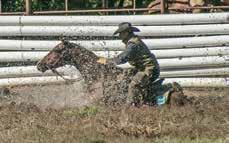

are in herds of less than 50 head. When those cattle go to market, most of them go to auction because of the size of producers’ drafts. Those cattle get dispersed, and the information is basically gone.”
Unless individual animal data accompanies an animal throughout the supply chain, it has little value, no matter its potential to add value. In the case of MFA Health Track producers, data has been collected on about 1 million head so far but could be used only sparingly to verify value added to the cattle.
Enter BlockTrust, a block chain system created by Gregg Barfield, president of the BlockTrust network. The system maintains the integrity of each data point associated with unique RFID numbers.
John has been working with Barfield, using Health Track data to ensure the system’s utility within supply chains.
In simple terms, think of block chain as an electronic ledger. Throughout the lifetime of each individual head of cattle, information associated with its unique RFID number can be added by whoever has permission to add the data. Those contributing the data grant permission for others to view the data. It’s
fraud-proof and permanent. It also creates a road map by which those involved can see where value accrued and potentially share the value.
“This opportunity you have with the genetic data, the growth data and carcass data is very rare. It’s an amazing opportunity for you to get some really important feedback to your genetic programs,” John told the crowd.
Mayo summed up the many opportunities at the outset.
“Everyone, every day can produce the champion beef animal. That’s a Prime Yield Grade 1. Everyone has a shot at being a champion every day,” Mayo says. “There aren’t many of those champions in the country today, but that should be the goal. How do we get there? And how do we create that animal where its mother still does a good job on grass, yet her calf converts well, gains well and performs well in the feedyard and then does that on the rail? That’s the idea, and we’re all striving for it.”
Sitings
1 Hereford Feedout Program—participants enroll a minimum five head of same-sex (steer or heifer) cattle for feeding within a designated delivery period; participants can enroll whole-pen groups outside of designated delivery period.
2 NJHA Fed Steer Shootout—participants enroll individual steers or pens of three steers. Reprinted with permission, Hereford World.
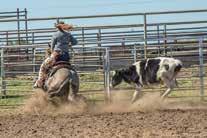
page 6 Summer 2023 For More Information, Contact: Farmers & Ranchers 785-825-0211 Mike Samples • 785-826-7884 Kyle Elwood • 785-493-2901 www.fandrlive.com Farmers & Ranchers Livestock Comm. Co., Inc. Salina, Kansas Your Kansas Connection for Ranch & Rope Horses Come buy your next winner with us October 15! Fall Classic Catalog Horse Sale Saturday, October 14, 10:00 AM Rope Horse Preview Friday, October 13, 6:00 PM 15th Annual F&R Futurity Friday, October 13, 2023, 10:00 AM $14,000 added money 26th Annual Fall Colt & Yearling Catalog Sale Farmers & Ranchers Livestock October 15, 10:00 AM
Marketing Feeder Cattle? Begin With the End in Mind Learn more about on-ranch management, building key relationships and finding the right feedyard.
By Lindsay
&
All good outcomes start with a plan. If you’re ready to maximize the value of your feeder calves, evaluate their marketing journey—beginning with the end.
Understanding what constitutes value takes an understanding of beef quality and yield thresholds that result in premiums and/or discounts. Generally, packers look for cattle that will garner a high quality grade (Certified Angus Beef ® (CAB®) brand, Prime, 100% Choice) and have excellent red meat yield. Realistically, very few do both exceptionally well.
To Steve Peterson, manager at Triple H Feedyard in Lebanon, Kan., the most important thing producers need to know prior to marketing cattle is where they are in terms of quality and where they want to be.
“I’ve got one producer and he’s fed cattle with me for almost 20 years,” Peterson says. “When he started, he
wouldn’t even have 50% Choice, and now his cattle will be 90% plus with 15% Prime high-yielding cattle.”
Progress like that starts when you’re making breeding decisions.
From the Ranch and Beyond
Selecting above-average genetics for important terminal traits, like marbling and feed conversion, gives you a head start on the progeny being worth more than market average.
“It goes back to genetics,” Peterson says. “You need to know whether you’re artificially inseminating, or buying bulls. Look at the $B (beef value index). See where those cattle index.”
Feed conversion is critical at the feedyard, which is indicative of average daily gain. Cattle that gain well are converting feed at an efficient pace with a genetic advantage.
To quantify feed conversion, use
records of prior performance or look to industry resources for assistance. Genomic tests and expected progeny differences (EPDs) can provide indicators of feed efficiency, but the most straightforward approach is to look at your bull battery and select for growth traits.
The AngusLink SM Genetic Merit Scorecard® (GMS) quantifies the genetic potential of a producer’s calf crop. By using current and past sire information, combined with cows’ breed makeup, calves are given three scores. Each of those scores—beef, feedlot and grid—ranges from 0 to 200, with 100 being industry average. The higher the score, the better.
Producers who want to communicate their calves’ potential carcass merit can use the CAB Targeting the Brand™ logo alongside GMS grid scores. The Targeting the Brand logo will appear on scorecards for groups that meet phenotypic (the CAB live-animal specifica-
tion) and genetic (grid score of 125 or better) thresholds.
Universally, health is the primary concern. It’s affected by the vaccination protocol, nutrition management and animal handling on your operation. To increase marketability, all those things need to match best practices from your veterinarian and nutritionist. Be sure to keep good records, too.
When you’re ready to sell, be honest about your calves’ genetic package and how they have been managed. Determine if your cattle will meet, and possibly exceed, the standards packers are looking for to earn a premium. If you have superior genetics and
Michael CN Dazler Boon Step AQHA $13,000.00 2013 palomino gelding by grandson of Sonny Dee Bar—head horse

Crum, Tyler & Jessie Patches
$12,500.00 2010 paint mare pony—family pony
Woods, Jake & Ashley Rythms Ruby Dew AQHA $12,000.00 2008 sorrel mare granddaughter of Smart Little Jerry—reined cow horse

Nothern, Dustin Spoiler
$12,000.00 2010 palomino gelding grade—head horse

Higgs, Franklin D. Cactus Rondo Bud AQHA $10,000.00 2018 sorrel gelding by Cactus Rondo—ranch horse

10 Beverlin, Casey & Jamie Texas Fax AQHA $9,700.00 2016 black gelding by Texas Top Star—ranch horse
17 Lilley, Josh Jinxed Gin AQHA $9,500.00 2016 sorrel gelding grandson of Paddy’s Irish Whiskey—team rope, ranch
103 Jess, Dylan Ima Harlan Belle AQHA $9,000.00 2017 bay mare granddaughter Two Eyed Red Buck—team rope

13 Louder, Curtis Alotta Lynx Dr
22
4
18
50
gelding grandson Docs Hickory—ranch

For More Information, Contact: Farmers & Ranchers • 785-825-0211 | www.fandrlive.com Mike Samples, Manager • 785-826-7884 | Kyle Elwood • 785-493-2901 High Seller, Lot 9 4th High Seller, Lot 67 ($19,000) 3rd High Seller, Lot 28 ($20,000) Ranch Horse Champion 2nd High Seller, Lot 21 High Selling Pony, Lot 35 ($12,500) Spring Spectacular Sale Farmers & Ranchers Top 5 Avg. $20,500 Top 10 Avg. $16,200 Top 15 Avg. $13,850 Top 20 Avg. $12,410 Lot Consignor Name Assoc $ Notes 9 Stover, Jamie Smoothly Styled AQHA $24,500.00 2017 sorrel mare by Smooth As A Cat—ranch, team rope, broodmare 21 Harris, Chad My Bloodrunsblue AQHA $22,000.00 2019 bay roan gelding grandson of Mecam Blue—ranch, head horse 28 Torres, Salvador TFR Gooda Oak AQHA $20,000.00 2018 sorrel gelding grandson of Docs Oak—RHC winner 67 Bair, Britt Mr Rocket Player AQHA $19,000.00 2015 palomino gelding grandson of Mr Baron Red—family horse 79 Powell, Russell Hankies Wild Dancer AQHA $17,000.00 2012 grandson of Boonlight Dancer—ranch horse 45 O’rourke,
35
8
30
83
Grade
Grade
AQHA $9,000.00 2017
sorrel
Breeding,
AQHA $8,500.00 2019 bay
Petersen, Landon
Irish Luck AQHA $8,500.00 2017 sorrel gelding
Josh Jaycee Shudabeenblue
gelding grandson Royal Blue Quixote—ranch 123
Ogradys
by Streak Of Fayme—team rope, ranch, barrels
Beetison,
AQHA $8,000.00 2007 bay gelding
ranch
Merlin Watch Duke Shine
by Watch Jack Shine—team rope,
Hough,
AQHA $8,000.00 2016 sorrel gelding
Fourway Sugar—rope, ranch
George JS Red
by
Elwood,
Parrsshiningstar AQHA $8,000.00 2015 bay gelding by Four Flake Royal—ranch
Elwood, Kyle Cowhntnhikrydikrydoc AQHA $8,000.00 2008 dun gelding by Cat Dual—team rope
Danny Zan
120
Graber Runft
Paul Dykstra, Certified Angus Beef
“…you can tell a lot by looking, but the data doesn’t lie.”
—Steve Peterson
management that has protected the inherent value of your calves, and you communicate that to potential buyers, you’ll be ahead in the marketing game.
“A producer needs to know what he’s got: Has he collected carcass data? How do his cattle feed? How efficient are they?” Peterson says. “Those are things we look at.”
From there, build your knowledge base around what the market will reward based on feedyard and packing sector parameters.
Genetics, health and management are all pieces of background information you should have on your calves. Knowledge about your own calves is a powerful tool and can help you decide between selling or retaining ownership.
“I’ve had some of the best-looking cattle here, but they feed terrible,” Peterson says. “I’ve seen cattle that you think would grade 80% Choice, and they grade 60%. So, you know, you can tell a lot by looking, but the data doesn’t lie.”
Without the background and production data that garner special interest from buyers, start planning ways to get that information to make more-informed decisions at the ranch and in marketing. Otherwise, you may be settling for commodity prices.
Relationships Required
When it comes to marketing a group of calves, building relationships with

cattle feeders should precede the sell date. While it’s not too late to build a network when the cattle are ready to sell, it’s easier as a gradual process. Where do you start? Here are suggestions to begin fostering relationships.

Phone a friend. Use preexisting connections with other cattlemen and women who may be able to offer their network as a starting place.
Reach out to a university feedyard specialist in one of the major cattle-feeding states. They can offer suggestions on feedyards that align with your goals, and potentially connect you to the right person to call.
Consider agriculturally focused banks in dominant cattle-feeding states. Loan officers there do a lot of business with feedyards. They can
offer insights on reputable feeders.
Growing a strong network and relationship-building with feedyards has value for both selling and retained-ownership scenarios.
“You’ve just got to take each marketing scenario, sit down and address it,” Peterson says.
If you’re going to sell calves to a feedyard, develop rapport with the manager. In part, there should be a high level of trust on the quality of your calves and how they will perform. Ideally, your network includes multiple feedyard managers who have substantial knowledge on the type of cattle you are selling and who are willing to pay top dollar.
Communication is key to having a successful retained-ownership relationship. Both the rancher and
When buying bulls, selecting for higher $B will aid in feed conversion.
the feedyard need to understand the arrangement and be able to communicate fluidly and timely about performance and marketing options.
Choose Region, Yard
As you evaluate feedyards, study your feeder calves and where they would fit in the packer mix. If you have exceptionally high carcass quality, seek packers with a reputation for rewarding marketing grids.
Remember, several packers will pay good premiums for the right cattle, so don’t let perception limit reality.
CROSSBREEDING EASY GELBVIEH & BALANCER ® MAKE
CROSSBREEDING THAT COUNTS
Gelbvieh and Balancer ®genetics deliver maternal superiority in planned crossbreeding systems. Highly productive cows with adaptability, versatility, and stayability can have a positive impact on your bottom line. GELBVIEH.ORG
page 8 Summer 2023
This featured Jorgensen Motherlode donor is the topproduction female among four fantastic full sisters, recording a progeny weaning ratio of 115 and a progeny yearling ratio of 107 on her first three natural calves. Her son, Ideal 1925 Emulous of E1674, is the second top-seller of the 2022 Jorgensen Bull Sale to Charles Hancock of Wyoming. Her flush sister, Ideal 5123 of Res Marjorie, was selected by ZWT Ranch of Tennessee as the second top-selling cow of the 2022 Jorgensen Motherlode Female Sale where another full sister, Ideal 5118 of Res Marjorie, sold to Weiker Angus of Missouri. Still another full sister produced the Jorgensen Motherlode donor Ideal 7209 of 1168 Marjorie whose progeny dominated the 2023 Jorgensen 51st Annual Production Sale including Ideal Accolade 2558, the $100,000 record-selling lead-off bull. Maternal sisters include the Jorgensen Motherlode donor Ideal 7574 of 1281 Marjorie. The remarkable production history of twelve generations of this great family is portrayed in the classic example of Ideal 5143 of Res Marjorie whose generational maternal production ancestry for progeny weaning ratio and progeny yearling ratio read as follows: 115/107, 108/107, 121/109, 106/103, 110/102, 105/109, 104/106, 100/107, 107/108, 100/103, 102/103 and 103/104.


Selling:
• Jorgensen Bred Heifers


• Jorgensen Select ET Heifer Calves
Superior Cows From Generations of Maternal Production Data

1:00 pm (CDT), Saturday, September 16, 2023 at the ranch, Ideal, South Dakota Angus Female Sale 31250 265th Street • Ideal, SD 57541-9230 800-548-2855 • Fax 605-842-3595 www.jorgensenfarms.com American Angus Hall of Fame (816) 532-0811 • Jorgensen Motherlode Donors • Jorgensen Varsity Cows PROG WR 115 S he Sells! PROG WR 108 Ideal 5143 of Res Marjorie, Reg: +18243519, Sire: #+SAV Resource 1441, Dam: +Ideal 9147 of 4227 Ideal 5123 of Res Marjorie, Reg: +18243164 Sire: #+SAV Resource 1441, Dam: +Ideal 9147 of 4227 236 Flush sister to Ideal 5143 of Res Marjorie.
Also consider geographical location—where you’d like to feed cattle relative to the packing plant and feeding resources. Consider logical freight distance for cattle delivery, but also feed basis and weather. Corn basis varies widely and becomes more attractive in the Corn Belt due to proximity to grain. Yet weather and season of the year can play a big part in cattle performance, so measure the two issues in tandem.
If you’re willing to feed cattle across the map, contact feedyards in different regions and build a list of pertinent things to know about each.

Peterson suggests knowing the feedyard’s history as a basis for questions.
“What’s his death loss over the last two or three years? What is the projection on how the cattle will feed? How does the feedyard manage their cattle? Do they feed once or twice or
three times a day? What’s the weather like? Look at the health of the cattle,” Peterson says. “Those are the most important things.”
Overall, a cattle producer should compile a list of positives and negatives on cost, performance history, seasonality and packer access.
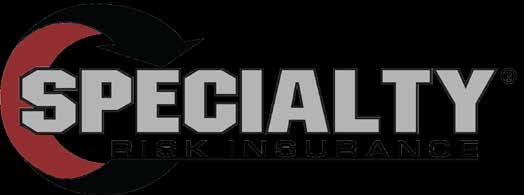
Use Your Resources
Maximizing the value of your calf crop takes focus and diligent work. Many resources are available to cattlemen and women, from professional consultation by nutritionists and veterinarians to marketing tools like the AngusLink GMS and CAB’s Targeting the Brand logo. Equally important is a strong network.

Begin with the end in mind, develop a plan for marketing calves and use your resources to maximize value.
Editor’s note: Lindsay Graber Runft is CAB director of producer communications. Paul Dykstra is CAB director of supply management and analysis.
Reprinted with permission from the 2023 Feeder-Calf Marketing Guide published by the Angus Beef Bulletin, available in its entirety online at https://bit.ly/23FCMG.
Editor’s message continued
Continued from page 3
consumers. It’s reassuring to interact on social media with academia, scientists, economists, other producers and industry professionals to rapidly ferret facts from fiction in an effort to communicate with consumers. Young producers are harnessing social media and using it as an inexpensive, valuable tool to sustain a dialogue with consumers interested in how food gets to their table.
Inventory and supply challenges during the pandemic were revealing to most of us. It’s easy to forget the seemingly never-ending food challenges experienced by many in our own country and certainly worldwide. The United Nation’s World Food Program reports, “828 million people worldwide are hungry—one in ten. Forty-three
million people in 51 countries are on the brink of famine or worse, and 343,000 are facing catastrophic levels of hunger.”
So, yes, I’m an unabashed optimist. The quality and safety of our food supply is unmatched anywhere around the globe. In a matter of seconds, anyone curious enough to ask or search can get an honest, transparent answer about beef. As producers at the beginning of a supply chain unmatched on Earth, we can never ever underestimate or undervalue the importance of progress and quality improvement.
As Americans, most consumers have multiple shopping options. They trust the shelves are stocked and the meat case is full of options with affordable, high quality and nutritious beef.
page 10 Summer 2023 Your Livestock Risk Protection Specialists. Protect Yourself against unexpected declines in the market. Visit us online at SpecialtyRiskInsuranceAgency.com/LRP or give us a call at 417-359-5470
Whether you’re looking to sell your calves to a feedyard or retain ownership, having a good relationship with a feedyard can increase the marketability of your calf crop.
Gardiner Angus Ranch’s six decades of total AI and ET breeding discipline, embracing the science to make dramatic change in the beef cattle population, and aggressively pursuing value-added marketing systems have helped deliver historic opportunities to the beef industry. MAKING BEEF BETTER starts in your pastures with proven genetics and ends with consumers’ exquisite eating experience. MAKING BEEF BETTER is our lifelong pursuit. Won‘t you join us?



19 TH ANNUAL FALL PRODUCTION SALE Monday, Sept. 25, 2023 • 9 AM At the ranch near Ashland, Kansas SELLING APPROXIMATELY 1,000 HEAD, INCLUDING: 450 Registered Angus Bulls 100 Bred Registered Angus Females 450 GAR-Influenced Elite Bred Commercial Angus Heifers As always, FREE DELIVERY! Watch the sale and bid live online at LiveAuctions.tv and Bid.SuperiorLivestock.com. Register to bid prior to sale day. A BROAD STATEMENT PROVEN EVERY DAY. STARTS IN THE PASTURE, NOT THE FEEDYARD… … IS REPEATABLE, … SUSTAINABLE, … COST EFFECTIVE,
PROFITABLE.
…
1182 CR Y | Ashland, Kansas 67831 | Office (620) 635-2156 | GAR@GardinerAngus.com | www.GardinerAngus.com The Henry & Nan Gardiner Family | Mark (620) 635-5095 | Greg (620) 635-0233 | Grant (620) 635-0382 | Cole (620) 635-0727 | Ransom (620) 635-0283 Proud to be a founding member of U.S. Premium Beef. More than $12.06 million in premiums and dividends have been paid to GAR customers using USPB delivery rights. GARDINER SERVICE AFTER THE SALE FREE DELIVERY | USPB DELIVERY RIGHTS | REPEAT BUYER DISCOUNT | FEEDLOT RELATIONSHIPS | MARKETING ASSISTANCE | REVENUE SHARING INTEREST | G3 AGE & SOURCE HIGH ACCURACY PROGENY PROVEN GENETICS | METHOD GENETICS BENCHMARKING | GENETIC CONSULTATION | THE GARDINER ANGUS RANCH GUARANTEE
Cattle Prices on Record Pace
By Wes Ishmael
Everybody knew cattle prices were going to increase, but the pace so far this year has likely exceeded the expectations of all but the most optimistic.
Cash fed steer prices set a nominal record high price the week ending April 10 when the five-area direct weighted average price reached $173.10/cwt. on a live basis. It climbed as high as $188.75 the week ending June 11 and headed into July at $181.33.
Feeder steer prices (600-700 lbs.) at the start of July were $61-$71/cwt.

higher year over year on a reginal basis — up 30-40% — according to USDA’s National Weekly Feeder and Stocker Cattle Summary.
“The ongoing story of tight cattle supplies combined with improving pasture conditions and lower yearover-year feed costs continues to push feeder cattle prices higher,” explain analysts with USDA’s Economic Research Service (ERS) in June’s Livestock, Dairy and Poultry Outlook. “Demand for limited supplies of feeder cattle remains strong. Feedlots are
looking to fill their feedyards to take advantage of lower feed costs and the prospects for higher fed cattle prices, while recent rains have improved the drought situation in a few areas, likely creating some demand for cattle to go on grass.”
ERS forecast feeder steer prices (750-800 lbs., Oklahoma City) at $209/cwt. in the second quarter, $224 in the third quarter and $226 in the fourth quarter for an annual average of $227. ERS pegged the annual average for next year at $226.50.
In June’s World Agricultural Supply and Demand Estimates (WASDE), ERS raised the projected quarterly five-area direct average fed steer price $5-$9 for the remainder of the year to an annual average of $171.70/cwt.
THE SUSTAINABLE CHOICE BEEFMASTER

ZERO MORTALITY 94% CHOICE OR BETTER

Fundamentals Drive the Bus
Reasons behind the prolonged, steeply higher price path have everything to do with significantly fewer cattle and reduced beef production in tandem with extraordinarily resilient consumer beef demand (more later).
The U.S. beef cow herd at the beginning of 2023 was the smallest since 1962, according to Derrell Peel, Extension livestock marketing specialist at Oklahoma State University (OSU), providing market insights at the recent Cattlemen’s Conference at OSU.
Likewise, Stephen Koontz, agricultural economist at Colorado State University pointed out in June that feedlot inventories were the snuggest in three years.
“Cattle on feed inventories continue to tighten from the peaks in 2022,” Koontz explained, in the Livestock Marketing Information Center’s In the Cattle Markets. “The beginning of June saw an inventory of 11.55 million, roughly even with the beginning of June 2018. And there will be more and more of this to come with the level of heifer and beef cow slaughter.”
Even so, Peel explained on-feed inventories likely won’t bottom (12-month moving average) until later this year or in 2025.
Estimated year-to-date total cattle slaughter through the last week of June was 580,000 head fewer (-3.4%) than the same time a year earlier. The same week estimated year-to-date beef production was 640 million lbs. less (-4.6%).
Nation’s Herd Still Contracting
ZERO PULLS
4.4 POUNDS PER DAY IN THE YARD 160 DAYS ON FEED
16% QUALIFIED FOR CAB PREMIUMS
AVERAGE YIELD GRADE 3

By all accounts, national beef cow liquidation continues this year while yearling fed heifer slaughter remains elevated, albeit less so than last year. History says prices will find their peak when heifer retention and reduced beef cow slaughter weigh further on beef production.
“The first step to stabilizing the beef cow herd is the reduction of beef cow slaughter and a lower rate of cow culling,” Peel explained in his midJune market comments. “Following record beef herd culling in 2022, beef cow slaughter is down 11.5% so far in 2023, a sign that herd liquidation is slowing. However, I suspect that, until recently, the decrease in total beef cow slaughter was masking some continued liquidation in the drought areas of the plains ... Beef cow slaughter is expected to decrease more sharply in the second half of the year.”

Definitive indication of herd expansion will come with increased heifer retention, according to Peel.
“Right now, no such signs exist, though I suspect that some heifer retention is beginning,” Peel said. “In

page 12 Summer 2023


Salina 235 S Santa Fe 785.825.2211 2860 S 9th 785.825.2211 Ellsworth 1500 Aylward 785.472.5588 McPherson 1301 N Main 620.241.8111 Abilene 1410 N Buckeye 785.263.4778 Lindsborg 118 N Main 785.227.3344 Hutchinson 1600 E 17th 620.694.4395 WE KNOW AG. Local Loan Decisions Fast and Efficient Competitive Rates fbkag.com NMLS# 528128 Call or visit us to discuss your operation financing needs.
Seedstock Plus Fall Sales!
On-Line Showcase Sale!
Opens August 19th - 8 a.m.
Closes August 19st - 8 p.m. (soft close)
Approximately 60 Balancer & Gelbvieh

Fall Bred & Open heifers & Embryo packages from Seedstock Plus Members!
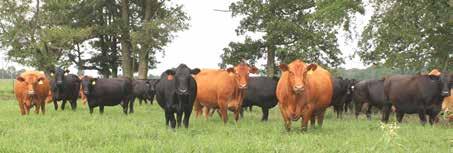
Watch the website & Facebook page for updates and information!
DVAuction Bid &
Buy at:
Fall Bull & Female Sale
October 21, 2023 * 12 noon
Joplin Regional Stockyards, Carthage, MO
Selling 150 Angus, Gelbvieh & Balancer bulls! ALL BLACK & 18 months old!! Also registered & commercial females!!

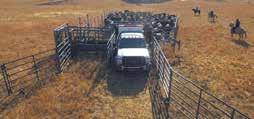
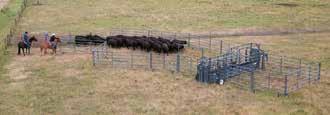
fact, heifer slaughter thus far in 2023 is fractionally higher than last year’s elevated level. Of course, the reduced heifer feedlot placement that follows increased heifer retention will show up as lower heifer slaughter only after several months. The July Cattle inventory report may be the first sign that shows an increased inventory of beef replacement heifers. Heifer slaughter is expected to start declining in the second half of the year.”
In the meantime, Peel noted the low inventory (Jan. 1) of replacement heifers—bred heifers calving this year and heifer calves to breed for calves in 2024.
“The bred heifer inventory is the lowest since 2011 and the inventory of replacement heifer calves is the lowest in the 23 years of data available,” according to Peel. “The number of replacement heifers is not enough to prevent more herd liquidation this year and likely not enough to do more than stabilize the beef cow herd in 2024. The big push for heifer retention will likely begin with weaning heifers this fall. These heifers will be bred in 2024, calve in 2025 and begin to increase beef production in 2026. It doesn’t seem possible to speed up the timeline.”
As herd expansion takes hold, reduced beef cow slaughter and in-

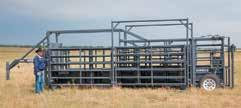
creased heifer retention will pull beef production lower for a time.
“In the last herd expansion that began in 2014, total cattle slaughter in 2015 dropped to the lowest levels since 1963, resulting in the lowest beef production since 1993,” Peel explained. “We can expect analogous reductions in cattle slaughter and beef production in 2024 and 2025 at least. Increased heifer retention will pull feedlot inventories down sharply and keep them low for the expected three years of heifer retention that will be needed for the next herd expansion. With drought seemingly on its heels, the process of herd rebuilding is poised to begin.”
Peel noted markets in the second half of this year revolve around the extent to which herd rebuilding begins.
Expansion
Timing Unclear
Increasing economic incentive has lots of folks thinking about expansion, but Mom nature continues to cap the prospects for many.
On the one hand, drought encompassed less of the nation the first week of July than the same time a year earlier. According to the U.S. Drought Monitor, 26.9% of the continental United States was experiencing drought, compared to 49.4% a year
Red Reward Fall Bull & Female Sale

November 4, 2023 * 12 noon
Wheeler Livestock, Osceola, MO
Selling 50 Gelbvieh & Balancer bulls!
ALL RED & 18 months old!!
Also registered & commercial females!!
Featuring the Complete Dispersal of Grand River Gelbvieh!
877-486-1160
toll free to request catalogs! Or email: john@seedstockplus.com
John cell# 660-734-1165
www.seedstockplus.com for updates & videos!
John McDonald
page 14 Summer 2023 The First Hydraulic Corral and still the Largest!
Processor • Pull on highway at speed limit. • Fits through any gate your pickup will. • Stable on uneven terrain. • Wheels on each panel and electric over hydraulic jack eliminates lifting— saves time. • Frame gates for sorting. • Transport wheels are permanent, no sliding off the axles and rolling out of the way. • Permanent sheeted adjustable alley. Rawhide Portable Corral 900 NORTH WASHINGTON ST., ABILENE, KS 67410 785.263.3436 www.rawhideportablecorral.com 3 Sizes Available!
Rawhide
by
earlier. For the week, 41% of cattle were in areas affected by drought versus 52% the previous year.
At the same time, drought lingered in some parts if the nation and expanded in others, hampering the opportunity to rebuild hay supplies severely depleted by drought.
El Niño’s arrival in June suggests eventual above-normal moisture in the Southeast, along the Gulf Coast and in the southern High Plains. If it’s strong enough, California and the Southwest may receive similar benefit. Typically, the opposite is true in the northern part of the nation.
Expanding drought in the Midwest cast doubts about corn yield, although USDA surprised markets with an estimated 94.1 million corn acres in the June Acreage report. That was 5.52 million acres more (+6%) than last year, and 2.1 million acres more than the March Prospective Plantings report. Corn acres would be the third highest planted acreage in the United States since 1944. Projected area harvested for grain of 86.3 million acres would be 9% more than last year.
USDA estimated the season-average farm price for corn received by producers at $4.80 per bushel in the June WASDE, which came out before the Acreage report.
“Once you start saving heifers for a herd expansion, you got to save heifers for at least three years before you slow down the rate of heifer retention enough, and the numbers have grown enough to allow more heifers to go back into the feedlot,” Peel explained at the cattlemen’s Conference. “So, as we tighten this thing up over the next year to 15 months, it’s going to be a while from that point before things can change.”
Consumers Keep Buying Beef
“The boxed beef composite value has rallied to almost $340/cwt., whereas it spent all of 2022 below $295 and much of that year between $255-$275,” Koontz explained. “There is clearly strong beef demand supporting the market. We also see this in a seasonally strong Choice-Select spread.”
Many meat and food item prices continue to increase but at a more moderate pace than last year, according to the latest Food Price Outlook from USDA’s Economic Research Service.
For instance, food at home prices were 0.1% higher month to month in May and 5.8% higher year over year. Year-to-date prices were 4.7% more than the same time last year when food at home prices were 11.4% more year over year.
More specifically, beef and veal
prices increased 1.5% month to month in May and 1.0% year over year. Year-to-date prices were 0.1% less than the same time last year when prices were 5.3% higher year over year.
By way of contrast, pork prices were 0.1% higher month to month but 2.9% lower year over year. Yearto-date, pork prices were down 1.9%. Poultry prices were 0.2% higher. month to month and 2.1% higher year over year. Year-to-date poultry prices were up 2.2%
“The Choice beef price (May) topped $8.08 per pound while the allfresh beef retail price exceeded $7.50 per pound,” said Andrew P. Griffith, agricultural economist at the University of Tennessee in his late-June market comments. “The Choice beef

price is a historic high and represents a $0.23 per pound increase from April. The all-fresh beef retail price for May was $0.18 per pound higher than April and the third highest monthly price on record and the highest it has been since November 2021.”
Although U.S. beef exports this year are less than last year’s record levels, international consumers continue to underpin demand.
April beef export value per head of fed slaughter was $441.70, the highest since last July, according to data released by USDA and compiled by the U.S. Meat Export Federation (USMEF).

However, April beef exports were 10% below last year at 111,416 metric tons, while value fell 18% to $859.5 million.
Through the first four months of 2023, beef exports were down 8% in volume (437,910 mt) and were 21% lower in value ($3.21 billion) compared to last year’s record pace.
“With U.S. beef supplies tightening, it’s difficult to keep pace with the remarkable export totals posted in the first half of 2022, but exports continue to account for a similar share of production as last year’s record,” says Dan Halstrom, USMEF President and CEO. “The rebound in travel and tourism – which is now gaining momentum in Asia – and related foodservice opportunities continue to support beef demand. In some countries we have also seen a recent easing of the inflationary pressure on consumers’ discretionary income.”
Faster, Cleaner, Easier DNA Collection

Eliminate the hassle of taking blood or hair samples. Allflex Tissue Sampling Units (TSUs) quickly capture clean, high-quality DNA. One squeeze and you’re ready for genomics in breeding and marketing. Plus, matched sets of Allflex TSUs, EID tags and custom visual tags make it easier to link performance data to genetics to market demand, authenticating your brand of cattle in the supply chain.
www.allflexusa.com







F&R Livestock Resource page 15 Copyright © 2023 Merck & Co., Inc., Rahway, NJ, USA and its affiliates. All rights reserved.
We Help You Bring It All Together.
-
Prolonged Drought Leaves Mark on Beef Industry
Drought throughout the Southern Plains has taken its toll on Oklahoma cattle producers over the past two years. Ponds are dry, pastures are brown and cattle herds have been liquidated, especially in western Oklahoma.

Drought Monitor maps from the
Oklahoma Mesonet consistently displayed a prominent drought line slashing across the state from northeast to southwest. Now that rain has fallen across much of the state this past month, weary producers wonder if a long-awaited recovery is near.
Fits
ONE PERSON can now SAFELY and EASILY process calves without concern of the protective mother cow!

Joan Bollin, WY - "I'm 62 and I tag 600 calves a year, no problem and we don't have calm cows. This will be my 3rd year using my catcher. I love it and highly recommend it to anyone."

Andy Downs, MT - "Best investment we ever made! We rave about the calf catcher to everyone!"


Bud Williamson, WV - "Your calf catcher was a virtual life saver for us! It sure makes one of the best times of the year, even better!"

page 16 Summer 2023
Cowman’s Best Friend at Calving Time!
Processing!
A
Safe
Now available with digital scale!
ATVs
UTVs!
and
local
PRICING
Watch Action Video at SafetyZoneCalfCatchers.com For
dealers or to order, call 877-505-0914 today! FACTORY DIRECT
Difficult Decisions on the Horizon
Families who have devoted generations of blood, sweat and tears to their herds have held on as long as they can but could still face difficult decisions this summer.
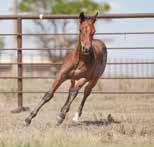
Lindsay Coker and her brother left careers in Houston to move back home with their own families to help their parents farm near Texola, Oklahoma. They grow cotton, wheat and hay while managing an Angus cow-calf operation. Some western Oklahoma producers like Coker live in an area

start of the turnaround. You’ve just got to have hope and faith that things will work out.”
Two-and-a-half hours north, rancher Johnny Owens owns yearlings near Buffalo in northwestern Oklahoma. He has 50% fewer cattle this year and said if his area doesn’t receive additional rain soon, he will be forced to sell his stock.

“Since last August, up until three weeks ago when we got a couple of


inches of rain, we’ve had almost no moisture whatsoever,” he said. “We have 20% of what our normal grass growth would be this time of year.”
After dusting in wheat last fall with no moisture, Owens and his Harper County neighbors are facing a failed wheat crop. Owens grazed his failed wheat, and others have followed suit to buy time.
“It’s too expensive to feed all winter and this summer,” he said. “Producers
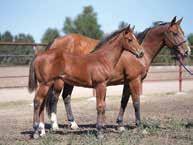

with cows have culled heavily and will begin liquidating herds if a turnaround does not occur within the next 30 to 60 days.”
Timely Rains for a Green Spring
In eastern Oklahoma, lush, green forage covers the landscape, a stark contrast to western Oklahoma’s cracked, bare earth. Cattleman Dax Burchett manages Burchett Cattle Co.
teetering in the extreme to exceptional drought category.
“My dad always taught me to not overstock, but that has gotten a little more challenging,” she said. “This past winter, we had the leanest pastures we’ve ever started with, and we had to supplement more with forage, cake and protein.”

Coker’s operation uses a pasture rotational program to ensure forages recover to maintain cattle grazing and minimize inputs. However, this method is more difficult to follow when grass is stunted or dormant from drought. As a result, additional hay must be purchased, and the concentrated, processed cake cattle feed made from distillers’ grains, soybean meal, sunflower meal and other crude protein is expensive.
When hay can’t be found and water is scarce, older cattle and those not bred are sold to reduce expenses. This year, the Coker family’s thorough pregnancy checking improved the operation’s efficiency.
“We knew it wasn’t going to be an ideal situation going into this past winter, so we wanted to give our cows an optimal chance to thrive and produce to the best of their ability,” she said.
The recent rain recorded in Texola has stirred a new sense of optimism, and Coker anticipates the day when pastures can thrive and provide much-needed forage.


“Everything is starting to green up, and that helps our mood and outlook,” she said. “I hope this is the

F&R Livestock Resource page 17 One of AQHA’s respected breeder programs! VIDEOS... will be online mid-September at www.jamisonranch.com or www.thelivestocklink.com JAMISON Quarter Horses 2271 County Road 74 • Quinter, Kansas 67752 Gordon Jamison (785) 299-0441 Merle High (717) 821-0309 Aden Glaze (785) 475-4125 Selling 120 Quarter Horses 50 Seasoned Ranch Horses & Started Performance Prospects 50 2023 Foals 20 Jamison Program Broodmares • Guest Consignor Santa Fe Ranch • • Preview on the 4th starting at 1:00 (central time) • Sale on the 5th - 12 Noon (central time) Additional preview at 9:00 the morning of sale Thursday • 12 NOON October 5, 2023 at the ranch, Quinter, Kansas 20th Annual Breeders & Ranchers PRODUCTION SALE Sun Frost, Driftwood and Hancock performance-bred horses from Western Kansas’ big ranch country Powerful 2019 Sun Frost/Three Jay Colonel • Bay 15.1 H gelding with stature, trainability and extra class! JA Roan Bar Oaks – (Flame) Two Sale Highlights.... Stout, standup 2019 Sun Frost/Leo Hancock Hayes/Docs Oaks Sugar • 15.1 H sorrel gelding with a get-along attitude! JA Frostem Jaydrift – (Ace) For more information contact: www.jamisonranch.com
FALL BULL SALE
in Talala with his father and uncle and has worked as director of sales and operations at Mid America Feeds for 25 years.
“We’re on the edge of stocker country, but we also have a lot of smaller, mom-and-pop operations that rely on hay when they don’t have a lot of forage,” Burchett said.
Mid America Feeds typically provides feed for about 300,000 head of cattle in northeast Oklahoma every day, but drought conditions earlier this year forced local producers to cull at least 10% of their herds. The reduction in numbers trickled down to lower feed sales at the mill.

Burchett’s cow-calf and stocker operation was also impacted by the drought with diminished pond water, hay and forage. The Burchett family pregnancy checked cows and heifers, culling 10% to 20% of the herd. Average weaning weights dropped, and fewer cows bred back from the previous year. A dry, barren landscape began to affect the livestock that lived on it.
“We were watering a large percentage of our animals on city water, which because we live next to a large lake wasn’t an issue, but we would have had to reduce numbers due to water needs,” he said.
PROGRAM to SADDLE UP WITH
But in February, Burchett’s area of northeast Oklahoma received a lifesaving rain that filled some ponds and alleviated the drought’s intensity. Timely showers also fell in March and April, and now Burchett is developing a pasture recovery plan after two years of poor forage yields.
“We’re going to top dress our pasture more for a quicker healing process,” Burchett said. “Even in drought years, we didn’t skip on weed spray. You want every little bit of moisture to go to grass, and we’ve fertilized a little now that it’s more affordable.”
Currently, Peel said calf market prices are 40% higher than they were in October 2022, and those prices will
jump even more when drought conditions subside enough to the point that cows and heifers are pulled off the market and retained on the ranch.
High prices are a good thing in theory, but for those ranchers who had to liquidate and now want to get back in the game, the price to play will be very expensive.
“High input costs and drought impacts mean a little bit slower recovery process than the last drought,” Peel said, referring to the drought from 2011 to 2013. “We had two years of high cattle prices in 2014 and 2015, but this time around, we’ll see a relatively elevated cattle price situation for an extended period of time.”
Tighter Supplies, Higher Prices
While ranchers watch the skies for rain, beef consumers can expect to feel the effects of a drought-stricken industry. Beef production is expected to slow. Supplies will tighten, and shoppers will pay higher prices for beef.

“Next year and beyond, we’re going to make a decreasing supply of beef even smaller, because to increase production long term, we will have to save heifers,” Peel said. “You can’t fix things fast—this industry turns slowly.”
Peel said current retail beef prices have been steady for the past 15 to 18 months. As cattle inventory drops to recover from the drought, consumers should expect higher prices at the meat counter.
“We’re setting ourselves up for better conditions in 2024. That’s the earliest I would expect to see the tightest squeeze on cattle sold at market,” Peel said.
As summer grilling season begins, consumers should take note of their grocery bill during the next few months. Chances are that the cost of a steak or ground hamburger will cost even more next year as Oklahoma endures the painstaking process of drought recovery.
page 18 Summer 2023
OCTOBER 28, 2023 • 10:30 AM CAMERON, TEXAS 700 PERFORMANCE ANGUS BULLS
invite you to consider being part of Prime Pursuits, a paradigm-changing program designed to bring together top producers with industry-leading genetics to deliver the best Angus beef to America’s table through a partnership with Walmart.
learn more, visit PrimePursuits.com or contact Warren White at 806.414.5858. FOR MORE INFORMATION, CONTACT ONE OF OUR TEAM MEMBERS: Tracy Woods 405.880.3866 Jarrod Payne 308.870.6348 Tyler Gray 208.590.6167 Jill Ginn 806.570.6185 CASEY WORRELL 512.413.1610 TO RECEIVE A SALE BOOK, PLEASE CALL 254.697.4401 OR VISIT 44FARMS.COM CLIENT: JOB#: 2023 Farm Print & Digital Ads TRIM: LIVE: BLEED: COLOR: PUB: CONTACT: Julie Tucker Julie@CogentIdeasInc.com RELEASE: INSERTION: FARM-23-003 2023 Fall Bull Sale Prime_FR Livestock_4_5x12_875_01mg.indd 1 7/3/23 5:02 PM
A
We
To
The #1 Pour-On dewormer in the industry doesn’t play games.1 Internal parasites can do a real number on your herd and your operation’s bottom line. Without dewormers, cow-calf producers can sacrifice more than $165 per head in lost returns.2 Settle the score before they cost you with Cydectin® (moxidectin) Pour-On or Cydectin® (moxidectin) Injectable. Cydectin delivers persistent control of costly parasites without posing a risk to environmentally beneficial dung beetles and earthworms.3,4


CydectinBeef.com (moxidec tin)












Keep Cydectin Out of Reach of Children.








 Cydectin, Elanco and the diagonal bar logo are trademarks of Elanco or its affiliates. ©2022 Elanco. 22-ELA-0656. PM-US-22-0389
1 Elanco Animal Health. Data on File.
2 Lawrence, J., Ibarburu, M. 2007. “Economic analysis of pharmaceutical technologies in modern beef production.” Proceedings, NCCC-134 Conference on Applied Commodity Price Analysis, Forecasting, and Market Risk Management; 10.
3 Suarez, V., Lifschitz, A., Sallovitz, J., et al. 2009. “Effects of faecal residues of moxidectin and doramectin on the activity of arthropods in cattle dung.” ScienceDiet.72 1551-1558.
4 Environmental Assessment. Cydectin® moxidectin 0.5% Pour-On for Cattle. Fort Dodge Animal Health, June 1997.
Cydectin, Elanco and the diagonal bar logo are trademarks of Elanco or its affiliates. ©2022 Elanco. 22-ELA-0656. PM-US-22-0389
1 Elanco Animal Health. Data on File.
2 Lawrence, J., Ibarburu, M. 2007. “Economic analysis of pharmaceutical technologies in modern beef production.” Proceedings, NCCC-134 Conference on Applied Commodity Price Analysis, Forecasting, and Market Risk Management; 10.
3 Suarez, V., Lifschitz, A., Sallovitz, J., et al. 2009. “Effects of faecal residues of moxidectin and doramectin on the activity of arthropods in cattle dung.” ScienceDiet.72 1551-1558.
4 Environmental Assessment. Cydectin® moxidectin 0.5% Pour-On for Cattle. Fort Dodge Animal Health, June 1997.
A couple of years ago we had a wreck going and needed a solution. ENDOVAC-Beef was it! A neighbor recommended the product. I knew it didn’t cost much and I knew what I was doing wasn’t working, so when I found out it covered E. coli, Salmonella, Pasteurella, and Mannheimia, I gave it a try. I vaccinated my calves and it worked! Plus, it’s just so easy on them. I give it to my calves around two months of age and again at weaning. The heifers I hold back get it again in June when they go through the chute. It’s just a good product.
The first year we started using ENDOVAC- Beef we had good results. The second year was even better because we implemented it in everything. I vaccinated my cows in April and gave them a booster in June to ensure full protection for my fall calvers and it solved all my scour problems. For those who have spring cows, I would give them a dose in the fall and again in January, about six to seven weeks before they start calving. Since implementing ENDOVAC-Beef, my medical bill went down and I’m just not treating calves anymore. I haven’t had to doctor one with foot rot either. I can tell you that vaccinating them is cheaper than losing them… it’s worth it.
Everything that goes through the chute; cows, calves, and bulls, gets a shot of Endovac at least twice a year now.
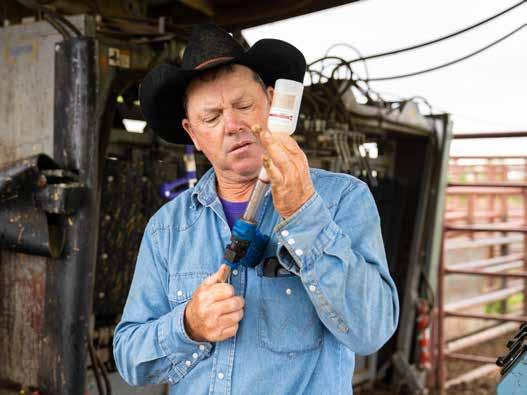 JW Henson, Hillview Farms
JW Henson, Hillview Farms
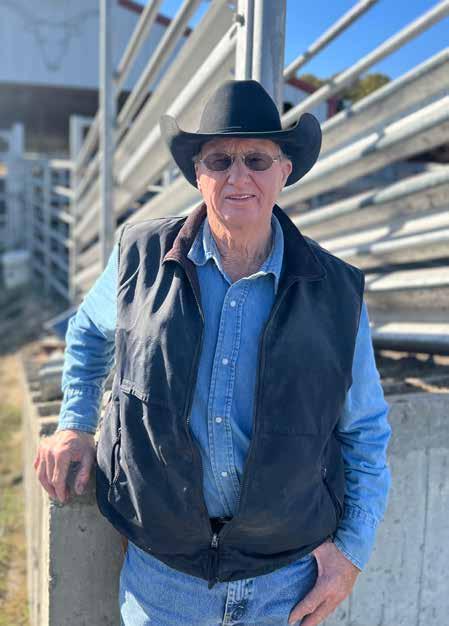
ENDOVAC-Beef has been a Game Changer for me. I run a good sized cow-calf operation in addition to starting cattle. 100% of my cattle get ENDOVAC-Beef. Since using ENDOVAC we don’t have to treat as many cattle for respiratory, or even other common problems like pinkeye and foot rot. I am getting my Pasteurella and the stimulant that makes the vaccine work better with ENDOVAC-Beef.
If everybody knew what I knew, everyone would be using it!

page 20 Summer 2023
Find your nearest rep at EndovacBeef.com 1-800-944-7563 l 6080 Bass Lane l Columbia, MO 65201
Brad Haun, Haun Ranch

























































































 JW Henson, Hillview Farms
JW Henson, Hillview Farms


